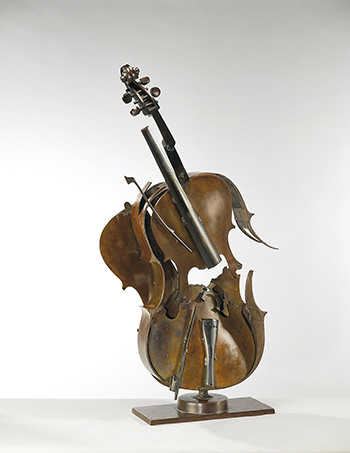EXHIBITED:
Arman , Galerie Pascal Retelet, Charleroi, Belgium, June 5 - September 6, 1993 (another edition exhibited)
Taiwan's Treasures: Western Art from Private Collections , Taipei Fine Arts Museum, Taipei, October 6 - December 2, 2001
ILLUSTRATED:
Arman , Graphing Grafossart, Galerie Pascal Retelet, Charleroi, 1993, color illustrated
Taiwan's Treasures: Western Art from Private Collections ,
Taipei Fine Arts Museum, Taipei, 2001, color illustrated, pp. 154-155, no. 49
This sculpture is to be sold with a certificate of authenticity signed by the artist.
Catalogue Note:
NOUVEAU REALISME
For Aman Fernandez, he was concerned with two things, objects and quantity. It is therefore not difficult to understand why many of his art works are the combinations of two and whenever they do they created the magnitude of awe. Arman is known for the accumulation of objects, the fascination with found or used objects was probably under the influence of his upbringing as his father owned a furniture and antique shop. Arman developed his interests in collecting antiques and other decorative objects, besides African art. When speaking of readymades, there’s no going without mentioning the work of “Fountain” by Duchamp in 1917. It was a pivotal moment when the concept of a work of art and craftsmanship was challenged. As these mass-produced, utilitarian objects were presented as artworks, they have paved the way for conceptual art emerged in the late 1960s.
In 1957, Arman’s work was organized to be shown at a group show together with 50 other artists, whose artworks are also included in this coming Spring auction, including Karel Appel, Vasarely, and others such as Lucio Fontana, Hans Hartung, Pablo Picasso, Salvatore Dali were also displayed at the Galerie Iris Clert in Paris. In 1959, the first accumulation of his works were shown at Galerie Apollinarie in Milan and Gerleris Saint Germain in Paris that year. What was more striking was that in 1960, Arman filled up an entire gallery space of Iris Clert with garbage, calling it ”Le Plein” (meaning “Full Up”) as his response to Yve Klein’s conceptual exhibition of “Le Vide” (“the void”) that took place three years ago. The importance of their actions encouraged the viewers to engage with the space itself, feel the conceptual space and raise a self-awareness, it also indicated zen philosophy. The exhibition invitation was made of sardine cans, aligned with the concept of the display and play of space.
In October 1960, Arman formed “Nouveau Realisme” (New Realism) with members included Yves Klein, Niki de Saint Phalle, and Christo, the manifesto was to search for “new ways of perceiving the real.” As such, a series of Arman’s Accumulations series were made in accordance to this declaration. As seen in his 1982 site specific work “Long Term Parking,” where 60 cars are encased in concrete stands to 18 meters high situated at Château de Montcel, France. For Arman, a thousand copies of the same object or a thousand pieces of the same object are essentially the same in intrinsic values. Arman typically favors the use of musical instruments as his primary material, he claims that violins are great performance props for artists as they have multiple facets to be explored.
Besides stacking up things would alter the views of people, so would separating them by cutting, removing and reconstructing after deconstructing. Such as a piece of a broken mirror, can a “Wounded” violin still play the same melody as a complete violin would? Through the process of separation, we are directed to look at things in a more detached, and objective way. For Arman, the importance of painting or sculpture should no longer be a platform to stress the excellence of craftsmanship or skills of an artist, instead, they should point out the genuine problems of post-industrialization, such as resulting the waste of resources due to mass-production as seen in Arman’s Garbage assemblage series works of art.
In 1966, Arman created the first piece of work with tube of oil paints, and placed in an acrylic box, was awarded with Prix Mazzoto. The Museum of Fine Arts in Taipei also has a collection by Arman, titled “Camaieu”. The work was executed with multiple paint brushes covered with red paint and layed on top of a canvas. Arman participated in the Venice Biennale in 1968 and the Documenta in Kassel. Besides museum collections, Arman’s large-scaled works can also be found in major public plazas. For example, the clock tower of “L'heure pour tous” is situated at Saint Lazare Station in Paris. Another work “A ma jolie” is made of dissected guitars and copper, it can be found at the Picasso Museum in Antibes. The impact that Arman has brought to the art world is spread across countries. In 1981, he was commissioned by the ministry of France to create “A la Republique”, to be presented in the presidential palace hall. The work was done as a tribute to the French Revolution, consistied 200 flags made of white marble with gilt bronze pole. In 1991, Arman was knighted by the French president, and received the National Medal of Honor in 1993.
